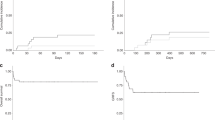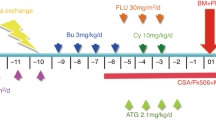Abstract
Hematopoietic stem cell transplantation is the definitive therapy for a variety of rare primary cellular immunodeficiency syndromes diagnosed in children. All primary immunodeficiencies benefit from early diagnosis and transplantation before the development of serious infections, which contribute to a significant increased risk of mortality following transplant. In the absence of a matched sibling, parental haplocompatible, matched unrelated donor and cord blood stem cells have all been utilized with varying degrees of success and immune reconstitution. The role of pretransplant conditioning in patients with SCID disease in terms of its effects upon T- and B-cell immune reconstitution and late effects is still under debate and will require further study.
This is a preview of subscription content, access via your institution
Access options
Subscribe to this journal
Receive 12 print issues and online access
$259.00 per year
only $21.58 per issue
Buy this article
- Purchase on Springer Link
- Instant access to full article PDF
Prices may be subject to local taxes which are calculated during checkout
Similar content being viewed by others
References
Muller S, Ege M, Pottharst A, Schulz AS, Schwarz K, Friedrich W . Transplacentally acquired maternal T lymphocytes in severe combined immunodeficiency: a study of 121 patients. Blood 2001; 98: 1847–1851.
Cavazzana-Calvo M, Fischer A . Gene therapy for severe combined immunodeficiency: are we there yet? J Clin Invest 2007; 117: 1456–1465.
Dror Y, Gallagher R, Wara DW, Colombe BW, Merino A, Benkerrou M et al. Immune reconstitution in severe combined immunodeficiency disease after lectin-treated, T-cell-depleted haplocompatible bone marrow transplantation. Blood 1993; 81: 2021–2030.
Bertrand Y, Landais P, Friedrich W, Gerritsen B, Morgan G, Fasth A et al. Influence of severe combined immunodeficiency phenotype on the outcome of HLA non-identical, T-cell-depleted bone marrow transplantation: a retrospective European survey from the European group for bone marrow transplantation and the European Society for Immunodeficiency. J Pediatr 1999; 134: 740–748.
Buckley RH, Schiff SE, Schiff RI, Markert L, Williams LW, Roberts JL et al. Hematopoietic stem-cell transplantation for the treatment of severe combined immunodeficiency. N Engl J Med 1999; 340: 508–516.
Antoine C, Müller S, Cant A, Cavazzana-Calvo M, Veys P, Vossen J et al. Long-term survival and transplantation of haemopoietic stem cells for immunodeficiencies: report of the European experience 1968–1999. Lancet 2003; 361: 553–560.
Myers LA, Patel DD, Puck JM, Buckley RH . Hematopoietic stem cell transplantation for severe combined immunodeficiency in the neonatal period leads to superior thymic output and improved survival. Blood 2002; 99: 872–878.
Cavazzana-Calvo M, Carlier F, Le Deist F, Morillon E, Taupin P, Gautier D et al. Long-term T-cell reconstitution after hematopoietic stem-cell transplantation in primary T-cell-immunodeficient patients is associated with myeloid chimerism and possibly the primary disease phenotype. Blood 2007; 109: 4575–4581.
Haddad E, Landais P, Friedrich W, Gerritsen B, Cavazzana-Calvo M, Morgan G et al. Long-term immune reconstitution and outcome after HLA-nonidentical T-cell-depleted bone marrow transplantation for severe combined immunodeficiency: a European retrospective study of 116 patients. Blood 1998; 91: 3646–3653.
Murphy WJ, Kumar V, Bennett M . Rejection of bone marrow allografts by mice with severe combined immune deficiency (SCID). Evidence that natural killer cells can mediate the specificity of marrow graft rejection. J Exp Med 1987; 165: 1212–1217.
O'Marcaigh AS, DeSantes K, Hu D, Pabst H, Horn B, Li L et al. Bone marrow transplantation for T-B- severe combined immunodeficiency disease in Athabascan-speaking native Americans. Bone Marrow Transplant 2001; 27: 703–709.
Gruhn B, Seidel J, Zintl F, Varon R, Tönnies H, Neitzel H et al. Successful bone marrow transplantation in a patient with DNA ligase IV deficiency and bone marrow failure. Orphanet J Rare Dis 2007; 2: 5.
Renella R, Picard C, Neven B, Ouachee-Chardin M, Casanova J-L, Deist FL et al. Human leucocyte antigen-identical haematopoietic stem cell transplantation in major histocompatiblity complex class II immunodeficiency: reduced survival correlates with an increased incidence of acute graft-versus-host disease and pre-existing viral infections. Br J Haematol 2006; 134: 510–516.
Grunebaum E, Mazzolari E, Porta F, Dallera D, Atkinson A, Reid B et al. Bone marrow transplantation for severe combined immune deficiency. JAMA 2006; 295: 508–518.
Dalal I, Reid B, Doyle J, Freedman M, Calderwood S, Saunders F et al. Matched unrelated bone marrow transplantation for combined immunodeficiency. Bone Marrow Transplant 2000; 25: 613–621.
Knutsen A, Wall D . Umbilical cord blood transplantation in severe T-cell immunodeficiency disorders: two-year experience. J Clin Immunol 2000; 20: 466–476.
Rao K, Amrolia P, Jones A, Cale C, Naik P, King D et al. Improved survival after unrelated donor bone marrow transplantation in children with primary immunodeficiency using a reduced-intensity conditioning regimen. Blood 2005; 105: 879–885.
Bhattacharya A, Slatter M, Chapman C, Barge D, Jackson A, Flood T et al. Single centre experience of umbilical cord stem cell transplantation for primary immunodeficiency. Bone marrow Transplant 2005; 36: 295–299.
Wijnaendts L, Le Deist F, Griscelli C, Fischer A . Development of immunologic functions after bone marrow transplantation in 33 patients with severe combined immunodeficiency. Blood 1989; 74: 2212–2219.
Roberts JL, Lengi A, Brown SM, Chen M, Zhou Y-J, O'Shea JJ et al. Janus kinase 3 (JAK3) deficiency: clinical, immunologic, and molecular analyses of 10 patients and outcomes of stem cell transplantation. Blood 2004; 103: 2009–2018.
Knutsen AP, Wall DA . Kinetics of T-cell development of umbilical cord blood transplantation in severe T-cell immunodeficiency disorders. J Allergy Clin Immunol 1999; 103 (5 Part 1): 823–832.
Hönig M, Albert MH, Schulz A, Sparber-Sauer M, Schütz C, Belohradsky B et al. Patients with adenosine deaminase deficiency surviving after hematopoietic stem cell transplantation are at high risk of CNS complications. Blood 2007; 109: 3595–3602.
Stiehm ER, Roberts RL, Hanley-Lopez J, Wakim ME, Pallavicini MG, Cowan MJ et al. Bone marrow transplantation in severe combined immunodeficiency from a sibling who had received a paternal bone marrow transplant. N Engl J Med 1996; 335: 1811–1814.
Haddad E, Le Deist F, Aucouturier P, Cavazzana-Calvo M, Blanche S, De Saint Basile G et al. Long-term chimerism and B-cell function after bone marrow transplantation in patients with severe combined immunodeficiency with B cells: a single-center study of 22 patients. Blood 1999; 94: 2923–2930.
Patel DD, Gooding ME, Parrott RE, Curtis KM, Haynes BF, Buckley RH . Thymic function after hematopoietic stem-cell transplantation for the treatment of severe combined immunodeficiency. N Engl J Med 2000; 342: 1325–1332.
Laffort C, Le Deist F, Favre M, Caillat-Zucman S, Radford-Weiss I, Debré M et al. Severe cutaneous papillomavirus disease after haemopoietic stem-cell transplantation in patients with severe combined immune deficiency caused by common gammac cytokine receptor subunit or JAK-3 deficiency. Lancet 2004; 363: 2051–2054.
Tjønnfjord GE, Steen R, Veiby OP, Friedrich W, Egeland T . Evidence for engraftment of donor-type multipotent CD34+ cells in a patient with selective T-lymphocyte reconstitution after bone marrow transplantation for B-SCID. Blood 1994; 84: 3584–3589.
Bertrand Y, Müller SM, Casanova JL, Morgan G, Fischer A, Friedrich W . Reticular dysgenesis: HLA non-identical bone marrow transplants in a series of 10 patients. Bone Marrow Transplant 2002; 29: 759–762.
McGhee SA, Stiehm ER, Cowan M, Krogstad P, McCabe ERB . Two-tiered universal newborn screening strategy for severe combined immunodeficiency. Mol Genet Metab 2005; 86: 427–430.
Chan K, Puck JM . Development of population-based newborn screening for severe combined immunodeficiency. J Allergy Clin Immunol 2005; 115: 391–398.
Filipovich A, Stone JV, Tomany SC, Ireland M, Kollman C, Pelz CJ et al. Impact of donor type on outcome of bone marrow transplantation for Wiskott–Aldrich syndrome: collaborative study of the International Bone Marrow Transplant Registry and the National Marrow Donor Program. Blood 2001; 97: 1598–1603.
Henter J, Samuelsson-Horne A, Aricò M, Egeler R, Elinder G, Filipovich A et al. Treatment of hemophagocytic lymphohistiocytosis with HLH-94 immunochemotherapy and bone marrow transplantation. Blood 2002; 100: 2367–2373.
Eapen M, DeLaat C, Baker K, Cairo M, Cowan M, Kurtzberg J et al. Hematopoietic cell transplantation for Chediak–Higashi syndrome. Bone Marrow Transplant 2007; 39: 411–415.
Rosenberg PS, Alter BP, Bolyard AA, Bonilla MA, Boxer LA, Cham B et al. The incidence of leukemia and mortality from sepsis in patients with severe congenital neutropenia receiving long-term G-CSF therapy. Blood 2006; 107: 4628–4635.
Zeidler C, Welte K, Barak Y, Barriga F, Bolyard A, Boxer L et al. Stem cell transplantation in patients with severe congenital neutropenia without evidence of leukemic transformation. Blood 2000; 95: 1195–1198.
Seger RA, Gungor T, Belohradsky BH, Blanche S, Bordigoni P, Di Bartolomeo P et al. Treatment of chronic granulomatous disease with myeloablative conditioning and an unmodified hemopoietic allograft: a survey of the European experience, 1985–2000. Blood 2002; 100: 4344–4350.
Westgren M . In utero stem cell transplantation. Semin Reprod Med 2006; 24: 348–357.
Amrolia PJ, Muccioli-Casadei G, Huls H, Adams S, Durett A, Gee A et al. Adoptive immunotherapy with allodepleted donor T-cells improves immune reconstitution after haploidentical stem cell transplantation. Blood 2006; 108: 1797–1808.
Author information
Authors and Affiliations
Corresponding author
Rights and permissions
About this article
Cite this article
Dvorak, C., Cowan, M. Hematopoietic stem cell transplantation for primary immunodeficiency disease. Bone Marrow Transplant 41, 119–126 (2008). https://doi.org/10.1038/sj.bmt.1705890
Received:
Revised:
Accepted:
Published:
Issue Date:
DOI: https://doi.org/10.1038/sj.bmt.1705890
Keywords
This article is cited by
-
Impact of Genetic Diagnosis on the Outcome of Hematopoietic Stem Cell Transplant in Primary Immunodeficiency Disorders
Journal of Clinical Immunology (2023)
-
Hematopoietic stem cell transplantation for cytidine triphosphate synthase 1 (CTPS1) deficiency
Bone Marrow Transplantation (2019)
-
TALEN-mediated functional correction of human iPSC-derived macrophages in context of hereditary pulmonary alveolar proteinosis
Scientific Reports (2017)
-
Cord blood transplantation is associated with rapid B-cell neogenesis compared with BM transplantation
Bone Marrow Transplantation (2014)
-
Use of V(D)J recombination excision circles to identify T- and B-cell defects and to monitor the treatment in primary and acquired immunodeficiencies
Journal of Translational Medicine (2013)



